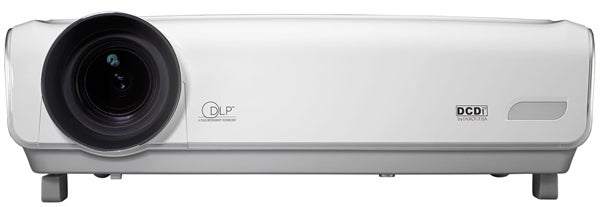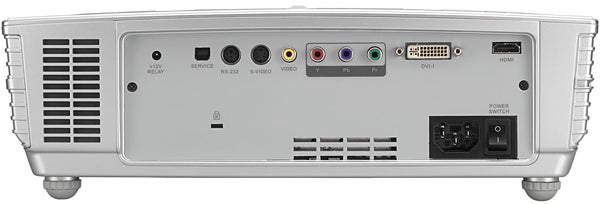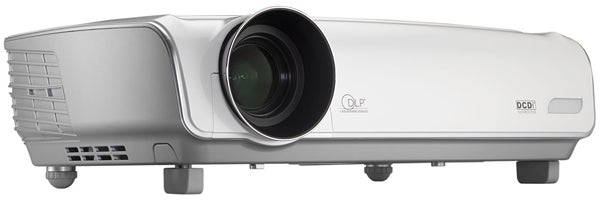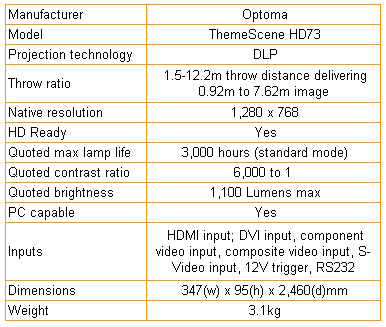Optoma ThemeScene HD73 projector Review
Optoma ThemeScene HD73 projector
DarkChip3 makes a showing in this competitively priced projector, but does John Archer like what he sees?

Verdict
Key Specifications
- Review Price: £1395.00
We don’t mind admitting that we’re pretty excited by Optoma’s ThemeScene HD73. Why? Because it uses a DarkChip3 DLP chipset – a relatively recent, high-specification 1,280 x 768 affair that usually only appears on projectors costing several hundreds of pounds more than the HD73.
Compared with the Texas Instruments DC2 chipset usually favoured at this level of the market, DC3 offers significant benefits when it comes to black level response and motion reproduction – so much so that we’re really hoping it might set new standards for its price, even outperforming the DC2-furnished Planar PD7010.
But our hopes stutter a touch as we lift the HD73 out of its box. For while its glossy white finish looks quite swish, the build quality feels rather flimsy, especially when it comes to the plastic zoom/focus wheels around the lens. Hmm. Hopefully this exterior flimsiness isn’t representative of the quality of the innards.

Thankfully our confidence is largely restored by the HD73’s remarkable claim of a 6000:1 contrast ratio – easily the highest figure seen on a DLP projector at this price point, and one which promises truly cinematic black levels. What’s more, this being a DLP projector, the high contrast ratio figure does not depend on reducing the picture’s brightness during dark scenes as happens with most LCD projectors.
More good-on-paper news comes from the discovery of no less than three picture processing systems designed to make images look better. Faroudja’s DCDi gets the ball rolling with its sophisticated de-interlacing system reducing the usual jagged look to curved contours. Then there are two systems derived from Texas Instruments: TrueVivid and BrilliantColour. As their names suggest, these are out to boost colour tone and saturation – though you should note that the version of BrilliantColour is ‘software only’; and you won’t find an advanced colour wheel ‘hardware’ component here like on one or two much more expensive projectors.
HD fans, meanwhile, will be chuffed to learn that the HD73 can handle 1080p signals delivered via either of its two digital inputs, one HDMI and one DVI. While we’re on the subject, other video inputs include component video, composite video, and S-Video, with the only disappointment being the lack of a dedicated D-Sub PC feed. You can get computer images into the HD73, but only by using the DVI and thus halving your digital video options.
Considering it’s presumably targeted at a fairly unsophisticated ‘entry level’ audience, the HD73 isn’t as easy to set up as it perhaps should be. Getting the image angled onto our screen and looking level was made frustratingly fiddly by some poorly designed drop-down legs and a finicky vertical image shifting facility. Also, the fact that the optical zoom level in the lens is restricted to 1.2x means that you may struggle to get the right image size from the position in your room where you most want the projector to go. We suggest popping over to Optoma’s website, where you can download a brochure on the HD73 that tells you what sort of projection throw distance you need for the HD73 to get various image sizes. The website also features a model-based distance calculator.
On the plus side, the projector does offer keystone correction in both the vertical and horizontal planes, and – perhaps controversially – is unusual in the projection world for sporting an ‘Image AI’ tool that can automatically adjust a variety of image elements based on a continual assessment of the incoming source material. We personally would rather trust our own eyes than that of some processors in the projector, but maybe that’s just us.

One final point we should pick up on before assessing the HD73’s performance is its native 1,280 x 768 pixel count. This actually equates to a widescreen aspect ratio of 16:10, rather than the 16:9 preferred by most cinema projectors. The reason for it, says Optoma, is that it makes the HD73 more of a multimedia all-rounder than most DLP models, since the 16:10 ratio is better suited to PC purposes than 16:9. But we can’t help but wonder if this might make the HD73 fall uncomfortably between the two AV and PC projection stools.
At first, it seems our fears are wholly unjustified, as the HD73 explodes into life with some strikingly vibrant and bright colours that blast off a screen with much more enthusiasm than is common for the budget DLP market. The delicious primary colour scheme of Kameo on Xbox 360 looks even more inviting than usual, while movies immediately look solid and engaging. BrilliantColour and TrueVivid definitely seem to be earning their corn here.
Of course, no amount of processing will get you great colours if your black level response isn’t up to scratch. So you won’t be surprised when we tell you that the HD73’s black levels are really quite outstanding. There’s hardly any greyness over even the darkest corners of the Nostromo during a run-through of Alien, and there’s enough greyscale subtlety to render decent amounts of shadow detail. Talking of detail, the HD73’s picture is also sharp enough to make HD sources look crisp, textured and, well, ‘HD’, even to quite prodigious screen sizes.
Striking though all these strengths are, they’re substantially undermined by the HD73’s rather serious problems with video noise. This takes two main forms, both related to the way single-chip DLP projectors work. First, there’s frequent and clear evidence of the ‘rainbow effect’, where the projector’s colour wheel system leads to the appearance of flickery stripes of pure red, green and blue colour, especially in your peripheral vision or over particularly bright parts of the image such as the ‘Alien’ lettering during the opening credits of Ridley Scott’s classic.

And secondly, there are pretty obvious amounts of dithering noise, where objects moving across the screen – especially if there’s any skin on them! – suffer with fizzing noise over the peaks of their features.
Chuck in on top of these two problems some occasionally rather odd colour tones during dark scenes and a tendency for fast moving objects to lose resolution, and you’re suddenly left with a fundamentally flawed picture performance that can really draw your attention away from the film/TV show/console game you’re supposed to be enjoying.
”’Verdict”’
In the end it’s hard to shake the feeling that the HD73 is too aggressive for its own good, focussing on the brightness and colour temperatures demanded by the PC industry to the detriment of the subtlety and noise suppression requirements of the AV world.
This situation proves once and for all that on-paper specifications aren’t the be-all and end-all of projector performance. For despite its DC3 credentials, the HD73 is actually considerably less enjoyable to watch than Planar’s keenly priced DC2-equipped PD7010.

How we test televisions
We test every TV we review thoroughly over an extended period of time. We use industry standard tests to compare features properly. We’ll always tell you what we find. We never, ever, accept money to review a product.
Trusted Score
Score in detail
-
Value 8
-
Image Quality 7

